How Long Does Rum Last Once Opened
Your opened bottle of rum can last several years when stored properly, thanks to its high alcohol content (around 40% ABV) acting as a natural preservative. While the spirit won't technically spoil, its quality may gradually decline after the first year, with subtle changes in taste and aroma becoming noticeable. To maximize shelf life, store your rum upright at a consistent temperature between 55-65°F (13-18°C), away from direct sunlight and heat sources. Keep the bottle tightly sealed to prevent oxidation, and consider transferring the liquid to a smaller container once it's below half-full to minimize air exposure. Understanding proper storage techniques can help you preserve your rum's distinctive characteristics for much longer.
This post may contain affiliate links. If you make a purchase through these links, I may earn a commission at no additional cost to you. Additionally, portions of this post may be generated using artificial intelligence (AI) technology. While we strive for accuracy, please be aware that AI-generated content may not always be perfect and should be fact-checked when necessary.
The Spatula Scoops
- Opened rum can last several years when properly stored due to its high alcohol content (40% ABV) acting as a natural preservative.
- While subtle taste changes may occur after one year, rum remains safe to drink indefinitely with proper storage conditions.
- Store opened rum at 55-65°F (13-18°C) with a tight seal, away from sunlight and heat sources.
- Transfer rum to smaller bottles when less than half full to minimize oxidation and preserve quality longer.
- Check for unusual odors, color changes, or floating particles as signs that rum quality has deteriorated.
The Shelf Life of Opened Rum
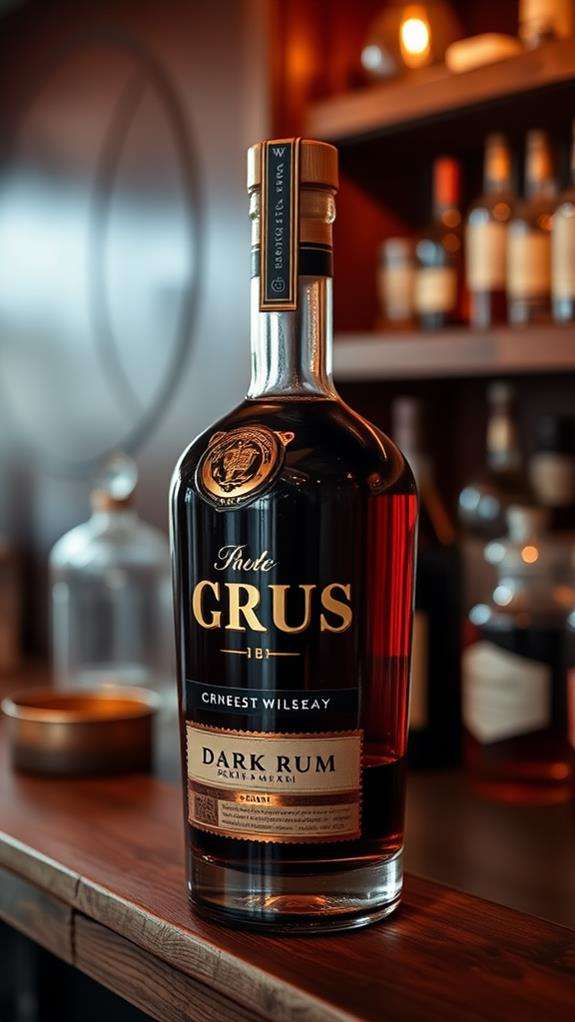
Generally, an opened bottle of rum can last several years when stored properly. Unlike wine or beer, rum's high alcohol content acts as a natural preservative, helping it maintain its quality long after you've cracked the seal. You'll find that most rums contain around 40% alcohol by volume (ABV), which greatly slows down any deterioration process.
The shelf life of your opened rum depends heavily on several key factors. First, you'll want to take into account how much liquid remains in the bottle – less rum means more air exposure, which can gradually impact the spirit's character. The storage conditions also play an important role. If you're keeping your rum at room temperature, away from direct sunlight, and ensuring the cap is tightly sealed, you'll preserve its quality much longer. You might notice subtle changes in taste after the first year, but these variations aren't typically dramatic enough to affect the rum's drinkability. While technically rum won't "go bad" regarding food safety, its flavors and aromas may slowly diminish over time, especially if it's exposed to excessive heat or light.
Proper Storage Methods
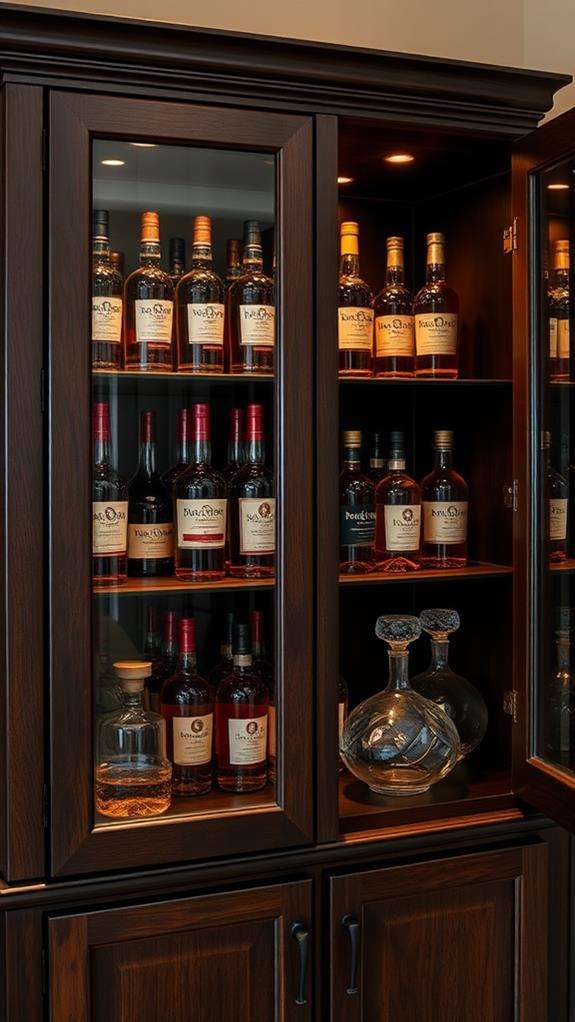
To maximize your rum's longevity, proper storage comes down to four essential factors: temperature, light exposure, seal integrity, and bottle position.
You'll want to store your rum at a consistent room temperature, ideally between 55-65°F (13-18°C). Avoid keeping it near heat sources or in places with temperature fluctuations, such as near windows or above your stove. Direct sunlight and artificial light can degrade your rum's quality, so you'll need to keep bottles in a dark place or cabinet. If you're storing collectible rums, consider using UV-protective glass containers.
The bottle's seal is vital – you must guarantee the cap remains tight after each pour, as oxidation will gradually alter your rum's flavor profile. When it comes to positioning, store your bottles upright, not on their sides. Unlike wine, rum doesn't need cork contact, and vertical storage prevents excessive liquid contact with the cap, which can lead to seal degradation. If you're using a cork-sealed bottle, you'll want to periodically moisten the cork by tilting the bottle briefly to prevent it from drying out and crumbling.
Signs of Spoiled Rum
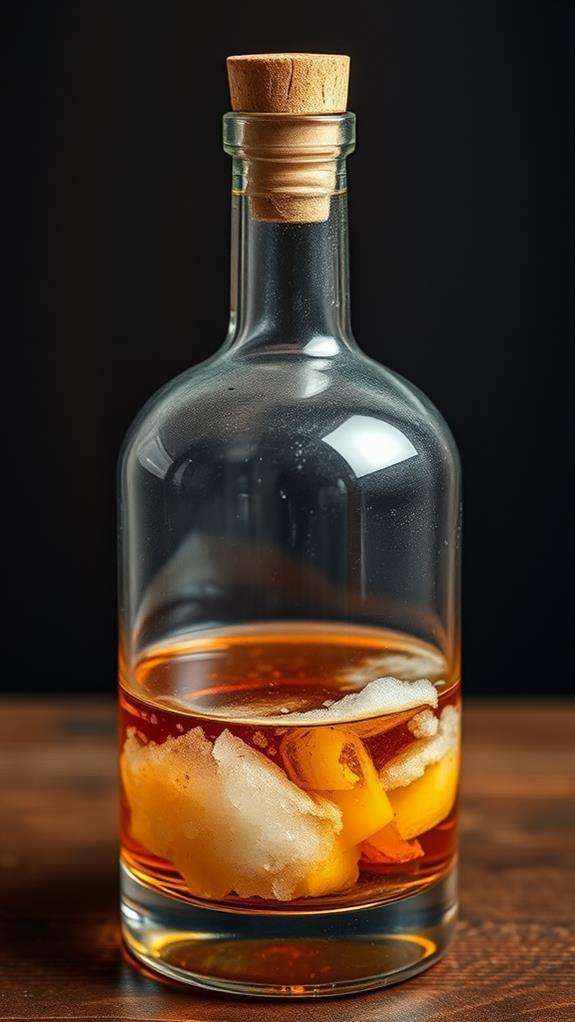
You'll want to check for several clear warning signs that indicate your rum has gone bad, including any unusual or musty odors that differ from the spirit's typical aroma. If you notice any changes in color, such as fading or darkening that wasn't present when you first opened the bottle, this could signal contamination or improper storage. The appearance of floating particles or sediment in your rum, which shouldn't normally be present, is another definitive sign that it's time to discard the bottle.
Off Smell or Odor
One of the first signs of spoiled rum is an unusual or unpleasant odor that differs from its normal aroma. Fresh rum should have a sweet, sugary scent with notes of vanilla, caramel, or tropical fruits, depending on the variety. If you notice any sharp, chemical-like, or musty smells, there's likely something wrong with your spirit.
When checking your rum's aroma, you'll want to pour a small amount into a glass and let it sit for about 30 seconds. Hold the glass a few inches from your nose and take a gentle sniff. If you detect any hints of plastic, wet cardboard, or vinegar-like scents, your rum has probably been compromised. These off-putting odors often result from oxidation, which occurs when the alcohol reacts with air over time. You might also notice metallic or medicinal notes, which can indicate that the rum has been exposed to excessive heat or light.
Don't confuse the natural ethanol smell of alcohol with spoilage, though. While strong alcohol fumes are normal, particularly in higher-proof rums, they shouldn't be accompanied by any strange or offensive odors.
Changes in Color
Keeping a close eye on your rum's color can help spot potential spoilage issues. While rum naturally varies in color from clear to dark amber, depending on its variety and aging process, you'll want to watch for any unexpected color changes that might indicate problems.
If you notice your rum becoming noticeably lighter than its original color, this could suggest exposure to excessive light or heat, which can degrade the spirit's quality. On the other hand, if your rum darkens considerably, it might indicate oxidation or contamination. You'll also want to look out for any cloudiness or floating particles, as premium rum should maintain its clarity throughout its shelf life.
For dark rums, pay attention to any dramatic shifts in hue, especially if it takes on a muddy or unnaturally dark appearance. Light or white rums should remain crystal clear – any yellowing or browning suggests potential issues. If you store your bottle in direct sunlight, you might notice the rum developing a slightly different tint, which is why it's best to keep it in a cool, dark place to maintain its original color profile.
Floating Particles Present
The presence of any floating particles or sediment in your rum bottle should raise immediate concern. While some aged rums might naturally contain harmless sediment from the barrel-aging process, unexpected particles often indicate contamination or spoilage. You'll want to examine these particles carefully, as they can tell you whether your rum is still safe to consume.
If you notice small, dark specks that appear to be from wood or natural compounds, they're likely harmless remnants from the aging barrels. However, if you spot fuzzy, cloudy formations, or crystalline structures, you're probably dealing with mold growth or sugar crystallization, neither of which is safe for consumption. To check for particles effectively, hold your rum bottle up to a bright light and gently tilt it, allowing any sediment to move freely.
You shouldn't attempt to filter out suspicious particles and drink the rum anyway. If you're unsure about the nature of the floating matter, it's best to err on the side of caution and dispose of the bottle, as consuming contaminated spirits can lead to serious health issues.
Factors Affecting Rum Quality
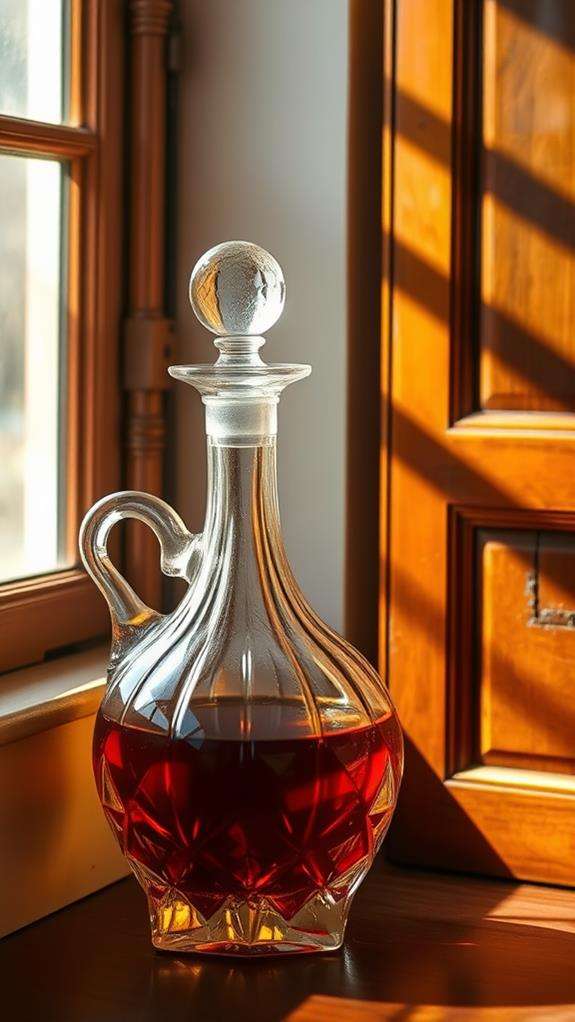
Your rum's quality will depend heavily on two critical factors: storage temperature and oxidation exposure. When you keep your rum at room temperature or slightly cooler (60-70°F), you're helping preserve its original characteristics and preventing unwanted chemical reactions that can alter its taste. While temperature plays its part, the amount of oxygen that interacts with your rum over time is equally important, as each time you open the bottle, you're introducing new air that gradually changes the spirit's chemical composition and flavor profile.
Storage Temperature Matters
Proper temperature storage plays an essential role in preserving your rum's quality and flavor profile. When you're storing your opened rum bottle, you'll want to maintain a consistent temperature between 55-65°F (13-18°C). Extreme temperature fluctuations can cause the liquid to expand and contract, potentially compromising the seal and accelerating oxidation.
- Room temperature storage (65-75°F) is acceptable for short-term storage, but you'll notice better preservation at slightly cooler temperatures
- Avoid keeping your rum near heat sources like direct sunlight, stovetops, or appliances that generate warmth
- Don't store rum in your refrigerator, as the cold temperature can cause the flavors to become muted and the texture to become slightly viscous
- If you're storing rum in a basement or cellar, monitor humidity levels to prevent label damage and potential cork deterioration
Temperature stability matters more than achieving a perfect specific temperature. You'll want to avoid moving your rum between areas with noticeably different temperatures, as this can impact the spirit's chemical composition and accelerate the aging process. Remember that consistent conditions will help maintain your rum's intended characteristics longer.
Oxidation Over Time
Once rum is exposed to air, oxidation begins affecting its flavor profile and quality. When you open a bottle, oxygen molecules start interacting with the alcohol compounds, gradually transforming the rum's chemical composition. This process can either enhance or deteriorate your spirit's characteristics, depending on how you manage the exposure.
You'll notice that oxidation's effects become more pronounced as the liquid level in your bottle decreases, since there's more air space for oxygen to interact with the rum. The first changes you might detect include subtle alterations in color, aroma, and taste. Initially, some rums might actually benefit from minimal oxidation, as it can help "open up" the flavors, similar to what happens when you let a wine breathe. However, extended exposure will eventually lead to degradation.
To minimize oxidation's impact, you'll want to transfer your rum to a smaller bottle once it's less than half full, reducing the air-to-liquid ratio. This practice, known as "bottling down," helps preserve the rum's original characteristics by limiting oxygen exposure and slowing down the oxidation process.
Best Practices for Serving
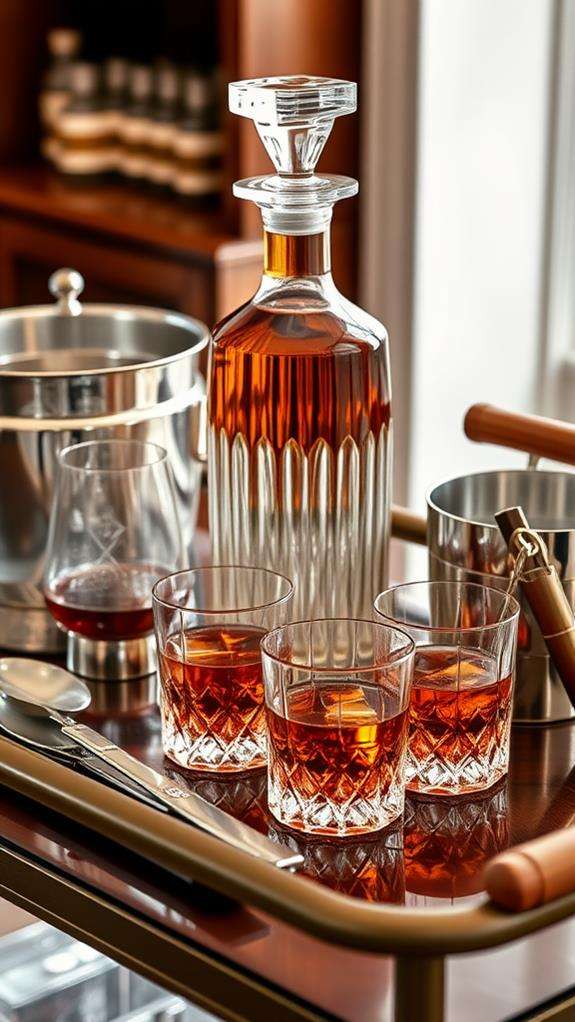
To get the most enjoyment from your rum, serving it at the right temperature and in appropriate glassware makes a significant difference. For sipping rums, you'll want to use a tulip-shaped glass or snifter that concentrates the aromas and allows proper appreciation of the spirit's complex notes. While room temperature is acceptable, many connoisseurs prefer their rum slightly chilled to about 55-65°F (13-18°C).
- When serving aged or premium rums neat, allow the spirit to rest in the glass for 1-2 minutes before drinking, letting the aromatic compounds open up.
- For mixed drinks, use chilled glassware to maintain ideal temperature and prevent excessive dilution from melting ice.
- If you're serving spiced or flavored rums, consider using rocks glasses that accommodate ice and garnishes comfortably.
- Always handle your rum bottles by the base or body, not the neck, to prevent unwanted warming from hand contact.
Remember to store your serving glasses properly, keeping them dust-free and ready for use. If you're hosting a tasting, prepare separate glasses for different expressions to avoid flavor contamination and facilitate a proper evaluation of each rum's characteristics.
Common Storage Mistakes
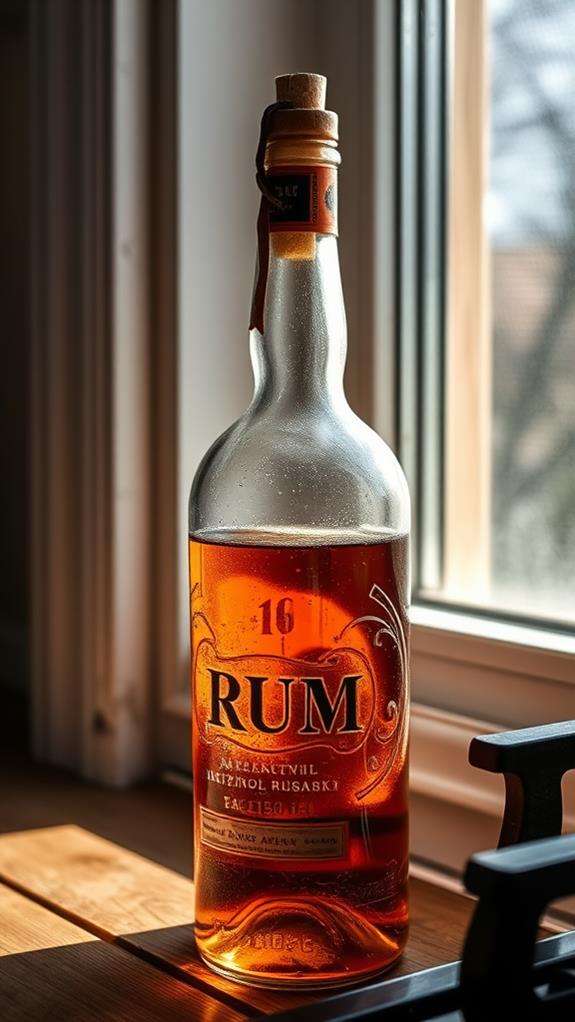
While serving rum correctly can enhance your drinking experience, poor storage practices can quickly diminish your spirit's quality. You'll want to avoid several common mistakes that can compromise your rum's integrity and taste profile.
One of the biggest errors you're likely making is storing your rum bottle near heat sources, such as above the stove or in direct sunlight. These conditions can cause temperature fluctuations that affect the spirit's chemical composition. You shouldn't leave the bottle cap loose or use makeshift stoppers, as this allows oxygen to enter and accelerate oxidation. Another mistake is storing rum bottles horizontally, which increases the liquid's contact with the cap and can lead to seal degradation.
You're also doing your rum a disservice if you're transferring it between containers, as each transfer introduces more oxygen and potential contaminants. Don't store opened bottles for extended periods with significant empty space inside – the extra air speeds up oxidation. Finally, keeping rum in the refrigerator or freezer isn't necessary and can actually mask the spirit's subtle flavors when you're ready to serve it.
Extending Your Rum's Lifespan
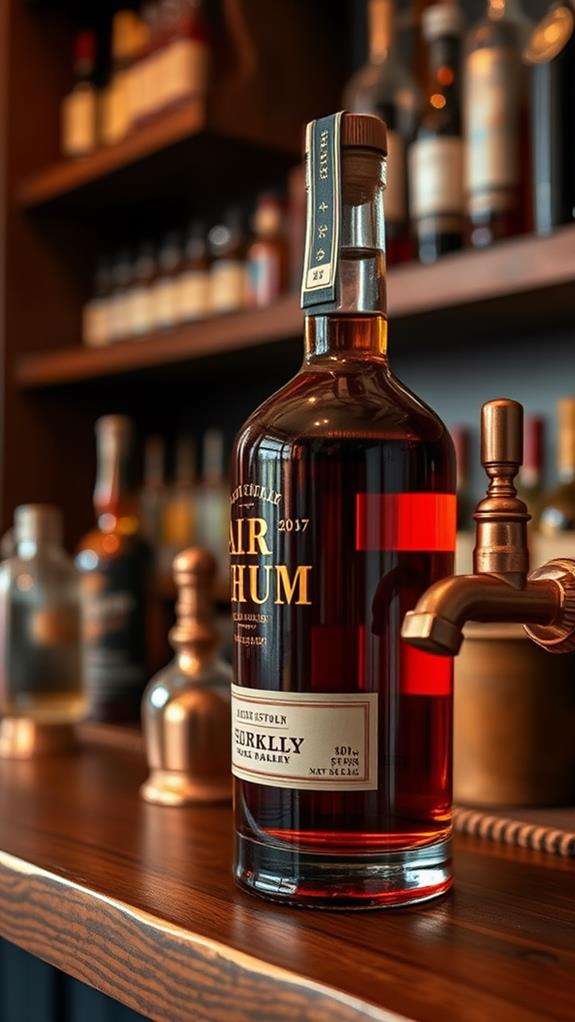
Although proper storage is essential, several additional strategies can help maximize your rum's shelf life. You'll want to focus on maintaining the spirit's quality through careful handling and smart preservation techniques that protect its complex flavor compounds and alcohol content.
- Transfer your rum to a smaller bottle when it's less than half full, reducing the amount of air that can oxidize the spirit and affect its taste profile
- Use specialized bottle stoppers with airtight seals, which create a better barrier against oxygen than standard cork or screw-top closures
- Keep a log of when you opened each bottle and regularly inspect your collection for any changes in color, aroma, or clarity that might indicate deterioration
- Consider using inert gas preservation systems, which replace oxygen with neutral gases like argon or nitrogen to prevent oxidation
Remember to handle your bottles carefully to avoid temperature fluctuations and excessive movement, which can accelerate aging and degradation. When serving, don't leave the bottle open longer than necessary, and always replace the cap immediately after pouring to minimize air exposure.
Frequently Asked Questions
Can Mixing Rum With Other Alcohols Affect Its Shelf Life?
When you mix rum with other alcohols, it doesn't substantially impact the rum's shelf life. However, what you're mixing it with matters. If you're combining rum with lower-alcohol beverages or mixers containing sugar, fruit juices, or dairy, the mixture will have a shorter shelf life than pure rum. You'll want to consume these mixed drinks within a few hours, while your unopened rum can still last indefinitely when stored properly.
Does the Color of Rum Change if Stored Near Direct Sunlight?
Yes, your rum's color will definitely change if you expose it to direct sunlight. You'll notice it becoming lighter or faded over time, as UV rays break down the compounds that give rum its rich color. This process, called photodegradation, doesn't just affect appearance – it can also alter the rum's taste and aroma. That's why you'll want to store your rum in a dark place, away from windows and direct light sources.
Is It Safe to Store Different Types of Rum in One Bottle?
While you technically can mix different rums in one bottle, it's not recommended. You'll risk altering the unique flavor profiles and characteristics of each rum, potentially creating an unbalanced blend. Additionally, different rums may have varying alcohol contents and aging processes, which can interact unpredictably. If you're interested in blending rums, it's better to mix them in small batches as needed rather than storing them together long-term.
Can I Freeze Rum to Make It Last Longer?
You don't need to freeze rum to extend its shelf life. Unlike wine or beer, rum's high alcohol content (typically 40% or higher) acts as a natural preservative, preventing bacterial growth. While freezing won't harm the rum, it won't improve its longevity either. In fact, freezing might dull the rum's complex flavors and aromas. You're better off storing your rum at room temperature in a dark place with the bottle tightly sealed.
Will Adding Fruit to Stored Rum Affect Its Quality Over Time?
Adding fruit to your stored rum will greatly impact its quality over time. You'll notice that the fruit's natural sugars and acids can alter the rum's flavor profile, and there's a risk of bacterial growth if the fruit begins to decompose. If you're determined to infuse your rum with fruit, it's best to consume it within 3-4 weeks and always strain out the fruit pieces before long-term storage.





